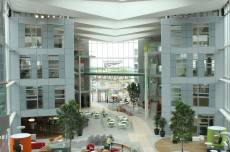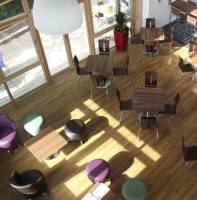October 31, 2013
9 to 5 consigned to history as flexible working patterns take over
 Flexible working practices don’t necessarily equate to working fewer hours. In fact, people are working increasingly longer hours as flexible working patterns consign the traditional 9-5 to history. A third of Britons are now working more than 10 hours a day, with a short or no break and are bringing work life into the home by responding to work emails, texts and calls in the evening. Research conducted by YouGov for business communications systems firm, RingCentral found that more than half (55%) surveyed now work more than 40 hours a week. As working patterns change, companies are seeing the importance of managing a geographically dispersed workforce (68%), and also believe that providing employees with the ability to work flexibly (78%) or from home (60%) are important for employee productivity levels. More →
Flexible working practices don’t necessarily equate to working fewer hours. In fact, people are working increasingly longer hours as flexible working patterns consign the traditional 9-5 to history. A third of Britons are now working more than 10 hours a day, with a short or no break and are bringing work life into the home by responding to work emails, texts and calls in the evening. Research conducted by YouGov for business communications systems firm, RingCentral found that more than half (55%) surveyed now work more than 40 hours a week. As working patterns change, companies are seeing the importance of managing a geographically dispersed workforce (68%), and also believe that providing employees with the ability to work flexibly (78%) or from home (60%) are important for employee productivity levels. More →











 The finest closing sentence of any novel in my opinion is that in The Great Gatsby. “So we beat on, boats against the current, borne back ceaselessly into the past.” It is a reference to the futility of our attempts to escape the past, even as we look to the future, dreaming of how “tomorrow we will run faster, stretch out our arms farther”. F Scott Fitzgerald was referring to people when he wrote it, and Jay Gatsby in particular, but it’s a passage that resonates in a number of ways, especially in those areas of our lives that deal most intimately with what it means to be human. And one of these is self-evidently the workplace, where any articular attempt to define the ideal office for a particular time, including the future, is complicated by the fact that we must always meet the needs of the beasts that inhabit it. Regardless of the tools we have at our disposal with which to work more effectively, or just plain ‘more’ we remain fundamentally the same animals we were thousands of years ago.
The finest closing sentence of any novel in my opinion is that in The Great Gatsby. “So we beat on, boats against the current, borne back ceaselessly into the past.” It is a reference to the futility of our attempts to escape the past, even as we look to the future, dreaming of how “tomorrow we will run faster, stretch out our arms farther”. F Scott Fitzgerald was referring to people when he wrote it, and Jay Gatsby in particular, but it’s a passage that resonates in a number of ways, especially in those areas of our lives that deal most intimately with what it means to be human. And one of these is self-evidently the workplace, where any articular attempt to define the ideal office for a particular time, including the future, is complicated by the fact that we must always meet the needs of the beasts that inhabit it. Regardless of the tools we have at our disposal with which to work more effectively, or just plain ‘more’ we remain fundamentally the same animals we were thousands of years ago.











October 29, 2013
What the endless debate about HS2 can teach us about how we work
by Mark Eltringham • Comment, Flexible working, Technology
A man working on a train
One of the most fascinating aspects of the debate about whether the UK should spend £50 billion (or whatever you think it might be) on the new HS2 rail network, is the way in which it has formed a touchstone for a discussion about how we work. But people on both sides of this debate can have things either spectacularly or misguidedly wrong. On one side, the people behind the scheme, including the Government, used the jaw-dropping assumption that nobody worked on trains as the foundation of a business case. That was the familiar sight of large organisations working their relentless way towards a number they wanted, regardless of inconvenient facts. This idea has now been so widely discredited and mocked that it has been dropped completely from the latest business case, tellingly the sixth in just three years. And yet on the other side, we have people arguing that we should travel less and use videoconferencing as an alternative to face to face meetings, which can be almost as problematic.
More →